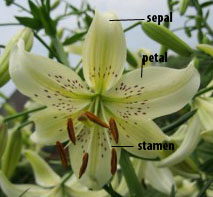 Traditionally, the Lily Family (Liliaceae) is huge and made up of diverse plants. It includes many ornamentals such as true lilies, tulips, agave, lily-of-the-valley, and amaryllis, as well as a few vegetables such as onions, leeks, garlic, and asparagus. Although some are edible, many are poisonous and present a special hazard to pets especially cats. Most are herbaceous perennials that die back to a storage organ after flowering and fruiting. There are about 6,000 species in 250 genera in the Lily Family and in recent years attempts have been made to split the family into many smaller families. This guide sticks to the traditional classification.
Traditionally, the Lily Family (Liliaceae) is huge and made up of diverse plants. It includes many ornamentals such as true lilies, tulips, agave, lily-of-the-valley, and amaryllis, as well as a few vegetables such as onions, leeks, garlic, and asparagus. Although some are edible, many are poisonous and present a special hazard to pets especially cats. Most are herbaceous perennials that die back to a storage organ after flowering and fruiting. There are about 6,000 species in 250 genera in the Lily Family and in recent years attempts have been made to split the family into many smaller families. This guide sticks to the traditional classification.
The key characteristics of the Lily Family are:
 Flower parts are in threes. There are usually three sepals, and three petals, six stamens, three stigmas on the three part ovary.
Flower parts are in threes. There are usually three sepals, and three petals, six stamens, three stigmas on the three part ovary.

 The sepals look like petals. Although sepals are usually green, those in the Lily Family are colored like the petals so the petals and sepals are often called “tepals”.
The sepals look like petals. Although sepals are usually green, those in the Lily Family are colored like the petals so the petals and sepals are often called “tepals”.
 Other characteristics that may aid in identification are:
Other characteristics that may aid in identification are:
Storage organs
- such as rhizomes, bulbs, or corms.
Narrow, parallel-veined leaves
- . Some shade plants may have net veining
Leaves are basal or alternate.
